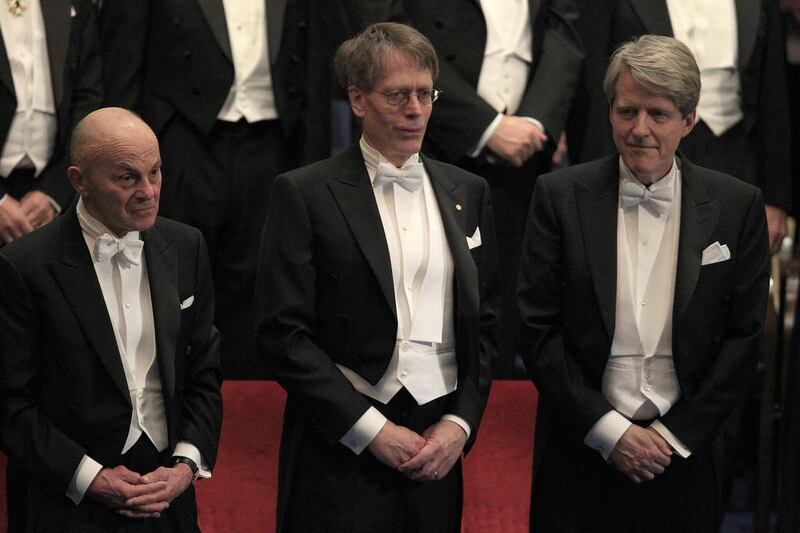Imagine if one of last week’s Nobel prizes had been shared between scientists who proved black holes exist and others who showed they don’t. The prize would lose its kudos faster than you could say “singularity”.
Yet tomorrow the world’s media will solemnly announce the winners of a prize whose judges have demonstrated such double-think without missing a beat.
No, it’s not the Ig Nobels, awarded at Harvard University each year for bizarre research that “makes you laugh, then makes you think”. It’s the Nobel Memorial Prize in Economic Sciences.
Despite often being hailed as “the economics Nobel”, the prize is actually nothing to do with Alfred Nobel’s venerable prizes. It was set up in 1968 by Sweden’s central bank, which was looking for a way to commemorate its 300th anniversary.
Like the original Nobels, winners are selected by the Royal Swedish Academy of Sciences, and they attend the same awards ceremony.
But the prestige attached to the economics prize has long been questioned – even by economists.
One of its early recipients, the Austrian-born macroeconomist Friedrich Hayek, declared that the prize risked conferring unwarranted prestige on its winners, admitting in his acceptance speech that “as a profession we have made a mess of things”.
If its sponsors were hoping the prize would acquire some of the lustre of the original Nobels, they must be wondering if they made a good investment.
In 2013, the prize attracted derision when it was awarded to two academics with mutually opposing views.
Eugene Fama, of the University of Chicago, is best known for arguing that markets are efficient – that is, they quickly make use of available information to set prices. That should make it impossible to beat the market, as the only other source of market movement is unpredictable random noise.
But Fama found himself sharing the prize with Robert Shiller, of Yale University, renowned for showing that markets aren’t efficient but are subject to the emotions of investors, which does lead to some predictability.
The events that unfolded when the two met in Washington DC after learning they’d both won the prize are telling.
According to a report in The New York Times, Shiller pointedly congratulated Fama on his success in beating the market while working for an investment group, which of course should be impossible if markets are efficient, as Fama claimed.
But before Fama could respond, another attendee of the meeting – the Nobel-winning Harvard chemist Martin Karplus – asked both economists an even more pointed question: “What understanding of the stock market do you really have?”
After all, Karplus said, the turmoil in the global financial markets seemed inexplicable using economics, “if one wants to call it a science”. Ouch.
Recipients of the “proper” science Nobels can afford to be a little smug. Certainly there’s little chance of, say, Karplus’s work predicting chemical reactions being proved flat wrong.
But his provocative question is one that continues to dog economic science: can it justify its own name?
One of the hallmarks of science is that it makes testable predictions. And by this criterion, economics has not fared well.
Take the salutary story of the discovery of the economic “law” linking inflation and unemployment.
Known as the Phillips Curve, it was published in the late 1950s by an eponymous New Zealand-born academic who had analysed decades of UK economic data. Simply put, the curve suggested that when unemployment falls, inflation increases and vice versa.
To economists trying to give their discipline the kudos of the hard sciences, the Phillips Curve had huge appeal.
By the early 1960s, the work of two leading American economists, Paul Samuelson and Robert Solow, had convinced policy-makers they could use the Phillips Curve to control national economies.
Inflation, once seen as the poison that propelled Hitler to power in the 1930s, was now regarded as the antidote for that other curse, mass unemployment.
As a result, many governments began trying to cut unemployment by allowing inflation to rise.
But no sooner had they begun using this new “law” than it ceased to apply. Unprecedented economic shocks such as the OPEC oil price hike showed the Phillips Curve to be anything but fundamental. Governments who had stoked inflation to control unemployment found themselves faced with “stagflation”, a supposedly impossible combination of stagnant growth and high inflation that blighted nations for years.
By then Samuelson had been awarded the economics Nobel for – as the official citation put it - “raising the level of analysis in economic science”. In reality, he had helped accelerate the transformation of economics into something that at least looked like physics, with lots of heavy-duty mathematics.
Yet as the emergence of stagflation proved, even the most complex equations cannot turn faulty assumptions into reliable insights.
Nor is it only governments that have fallen victim to attempts to make economics seem like physics.
The theories of the winner of the 1990 economics Nobel, Harry Markowitz, continue to blight the financial futures of individual investors to this day.
As a student at the University of Chicago in the 1950s, Markowitz developed techniques for working out the optimal mix of assets in an investment portfolio.
Instead of guessing that, say, a 60:40 mix of shares and bonds is the safest bet for a pension fund, Markowitz’s theory gives the combination that minimises the risks while still making a decent return.
All that’s needed is historical data on the performance of the various assets. His formulas do the rest.
Yet as with the Phillips Curve, there’s a huge assumption hanging over all this – that the past is a reliable guide to the future. While physicists have shown they can make that assumption, bitter experience shows that economists cannot.
More than 40 years after Hayek voiced his concerns about the economics Nobel, they still ring true. Whoever wins this year’s prize, one thing is for sure: the more like physics their work appears to be, the lower the chances it will stand the test of time.
Robert Matthews is Visiting Professor of Science at Aston University, Birmingham.






